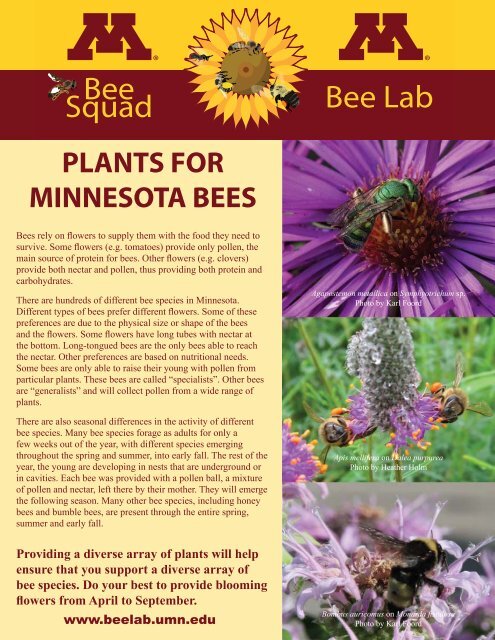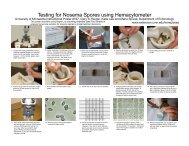Plants for Minnesota Bees - NEW LIST - Bee Lab
Plants for Minnesota Bees - NEW LIST - Bee Lab
Plants for Minnesota Bees - NEW LIST - Bee Lab
You also want an ePaper? Increase the reach of your titles
YUMPU automatically turns print PDFs into web optimized ePapers that Google loves.
<strong>Bee</strong><br />
Squad<br />
®<br />
J . G a r dn e<br />
®<br />
<strong>Bee</strong> <strong>Lab</strong><br />
PLANTS FOR<br />
MINNESOTA BEES<br />
<strong><strong>Bee</strong>s</strong> rely on flowers to supply them with the food they need to<br />
survive. Some flowers (e.g. tomatoes) provide only pollen, the<br />
main source of protein <strong>for</strong> bees. Other flowers (e.g. clovers)<br />
provide both nectar and pollen, thus providing both protein and<br />
carbohydrates.<br />
There are hundreds of different bee species in <strong>Minnesota</strong>.<br />
Different types of bees prefer different flowers. Some of these<br />
preferences are due to the physical size or shape of the bees<br />
and the flowers. Some flowers have long tubes with nectar at<br />
the bottom. Long-tongued bees are the only bees able to reach<br />
the nectar. Other preferences are based on nutritional needs.<br />
Some bees are only able to raise their young with pollen from<br />
particular plants. These bees are called “specialists”. Other bees<br />
are “generalists” and will collect pollen from a wide range of<br />
plants.<br />
There are also seasonal differences in the activity of different<br />
bee species. Many bee species <strong>for</strong>age as adults <strong>for</strong> only a<br />
few weeks out of the year, with different species emerging<br />
throughout the spring and summer, into early fall. The rest of the<br />
year, the young are developing in nests that are underground or<br />
in cavities. Each bee was provided with a pollen ball, a mixture<br />
of pollen and nectar, left there by their mother. They will emerge<br />
the following season. Many other bee species, including honey<br />
bees and bumble bees, are present through the entire spring,<br />
summer and early fall.<br />
Agapostemon metallica on Symphyotrichum sp.<br />
Photo by Karl Foord<br />
Apis mellifera on Dalea purpurea<br />
Photo by Heather Holm<br />
Providing a diverse array of plants will help<br />
ensure that you support a diverse array of<br />
bee species. Do your best to provide blooming<br />
flowers from April to September.<br />
www.beelab.umn.edu<br />
Bombus auricomus on Monarda fistulosa<br />
Photo by Karl Foord
This list is not inclusive of all plants that bees will visit in <strong>Minnesota</strong>. These are flowers that are particularly<br />
attractive to bees and can be easily integrated into most landscapes.<br />
= Tree = Herbaceous plant = Shrub = Full sun = Part-shade = Shade<br />
Early=March to May Mid=June to July Late=August to September<br />
Scientific name Common name Habit Sun Native<br />
Bloom<br />
time<br />
Honey<br />
bees<br />
Crataegus crus-galli Hawthorn X Early X X<br />
Geranium maculatum Wild geranium X Early X<br />
Penstemon grandiflorus Large beardtounge X Early X<br />
Salix discolor Pussy willow X Early X X<br />
Coreopsis lanceolata Lanceleaf coreopsis X Early to Mid X X<br />
Hydrophyllum virginianum Virginia waterleaf X Early to Mid X X<br />
Lupinus perennis Wild lupine X Early to Mid X<br />
Aruncus dioecus Goatsbeard X Mid X X<br />
Echinacea angustifolia Purple coneflower X Mid X X<br />
Lobelia siphilitica Blue lobelia X Mid X<br />
Pycnanthemum tenuifolium Slender mountain mint X Mid X X<br />
Agastache foeniculum Anise hyssop X Mid to Late X X<br />
Asclepias incarnata Swamp milkweed X Mid to Late X X<br />
Borago officinalis Borage Mid to Late X X<br />
Chamaecrista fasciculata Partridge pea X Mid to Late X X<br />
Cirsium discolor Bicolor thistle X Mid to Late X X<br />
Dalea purpurea Purple prairie clover X Mid to Late X X<br />
Eupatorium maculatum Joe-pye weed X Mid to Late X X<br />
Eupatorium perfoliatum Common boneset X Mid to Late X X<br />
Helianthus spp. Sunflowers X Mid to Late X X<br />
Hylotelephium telephium Autumn joy sedum Mid to Late X X<br />
Impatiens capensis Jewelweed X Mid to Late X X<br />
Liatris aspera Rough blazingstar X Mid to Late X X<br />
Monarda fistulosa <strong>Bee</strong>balm X Mid to Late X X<br />
Nepeta x faassenii Catmint Mid to Late X X<br />
Origanum vulgare Oregano Mid to Late X X<br />
Ratibida pinnata Yellow coneflower X Mid to Late X<br />
Silphium perfoliatum Cup plant X Mid to Late X X<br />
Trifolium hybridum Alsike clover Mid to Late X X<br />
Vernonia fasiculata Ironweed X Mid to Late X X<br />
Veronicastrum virginicum Culver’s root X Mid to Late X<br />
Solidago rigida Stiff goldenrod X Late X X<br />
Symphyotrichum lateriflorum Calico aster X Late X X<br />
Content and design by Elaine Evans<br />
Other<br />
bees




